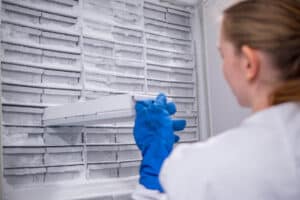
Changes in the life sciences industry are creating challenges for biobanks, making their ability to evolve imperative to their success in the future. More specifically, the proliferation of precision medicine and regenerative medicine further underscores the need for highly customized biospecimen collections. Applications such as companion diagnostic development, immuno-oncology research, regenerative medicine, liquid biopsy development, and even infectious disease research are all driving the need for access to more biospecimens from a more diverse patient population—with the datasets to match. To adapt, biobanks can benefit by shifting from a repository-dominant approach to one that serves as a conduit for just-in-time specimen collections from their inventory of patient populations. In so doing, the fundamental goal of enabling medical discovery can be extended and even possibly advanced.
A New Look at Just-in-Time Biobanking
Despite a recent shift in focus for biobanks from collection and storage to the distribution of stored specimens, most biobanks still have low utilization rates (less than 10% for most biobanks). [i] The first reason for this lack of use may be the fact that there is a collective hesitancy among biobanks to share specimens with external, commercial organizations—less than 10% of projects that necessitated banked specimens were for external commercial organizations. [ii] The second reason for under-utilization of specimens is that the actual samples themselves may not meet the researcher’s needs for specific specimen formats, accompanying datasets, or collection-to-delivery intervals. At iSpecimen, we believe this problem can be solved using a “just in time” biobanking model. This model would benefit biobanks, by increasing sustainability, and researchers, by increasing the customizability of specimens and data.
What Are Researchers Looking For?
To understand the need for just-in-time biobanking, in early 2022 iSpecimen surveyed life science researchers and asked from where they expected to obtain biospecimens in the upcoming year. Of the 67 unique organizations that responded, most of the respondents (63%) said that prospective collections would make up half or more of their specimen needs with only 37% of respondents indicating that most of their specimens would come from banked inventories. Similarly, researchers indicated their five top criteria when procuring samples: specimen quality, availability of specimens, specimen price , reliability of delivery, and ability to search for/target patients . These criteria explain why there is a steady, measurable shift from the procurement of banked specimens to the procurement of specimens via prospective collections.
Next-Generation Biobanking Solutions for Sustainability and Science
As prospective collection becomes increasingly popular in the specimen procurement space, next-generation biobanks must adapt their inventories and collection procedures to reflect industry and research demand. Moving forward, these biobanks will provide real-time feasibility assessments, a targeting procedure to enroll specific patients into collection studies, and workflow management tools for successful collection, processing, annotation, and distribution of specimens into research programs. These comprehensive solutions will require integrated access to “large-scale, detailed, and highly integrated patient data” that often exists in electronic silos within and across healthcare systems. The iSpecimen Marketplace® provides a technology platform to help streamline new data integration processes to support this evolutionary step. Let’s taken a deeper dive on data and how it is a cornerstone for progress moving forward.
Data is the Key
The next generation of biobanking solutions will tap into the power of the full electronic medical record system to obtain a detailed and comprehensive view of patient journeys.
Data Powers Patient Journey Search
Curated, longitudinal datasets will power advanced search capabilities. Longitudinal requests, such as the ability to specify a sequence of test results, treatments, and outcomes, will be enabled through the patient journey datasets. Biobank managers and researchers will have the ability to use unique study inclusion/exclusion criteria as selection filters to find both matching specimens that exist in biobanks as well as matching patient populations from whom biospecimens may be prospectively collected.
Data Drives Workflow Automation
Regardless of whether specimens are procured from existing inventories or from patients directly, integrated workflow software that utilizes the same healthcare dataset will then lead biobanking personnel through the process of picking, packing, and shipping selected specimens and data when they exist; or finding, approaching, and consenting patients and then collecting, packing, and shipping collected specimens to the appropriate researcher when specimens must be collected prospectively.
Data Supports Real World Data Opportunities
In addition to using healthcare data to support advanced patient and specimen search, curated healthcare and sample data may have tremendous value for real world data studies.
Data Informs Smarter Biobanking Strategies
Another key component of the next generation of solutions is the use of artificial intelligence (AI) to analyze demand data and biobanking inventories to help biobanks make more informed operational decisions.
The Future of Biobanking
The needs of researchers all over the world are redefining the meaning and composition of a biobank. Now, biobanks must think of themselves more as conduits for direct biospecimen collection, as opposed to a potentially stagnant repository of specimens. Biobanking solutions that offer a just-in-time model may be more successful at fulfilling the mission of enabling the advancement of life-changing medical discoveries.
For more information on biobanking sustainability, download our World Biobanking Report.
Learn about the iSpecimen Marketplace where you can browse millions of richly annotated, de-identified human tissue and biofluid biospecimens, in addition to hematopoietic and immune cell products and COVID-19 samples. You can join for free. Contact us with any questions you might have about the iSpecimen Marketplace.
[i] Henderson MK, Goldring K, Simeon-Dubach D. Advancing Professionalization of Biobank Business Operations: Performance and Utilization. Biopreserve Biobank. 2019;17(3):213-218. doi:10.1089/bio.2019.0005
[ii] Ibid.